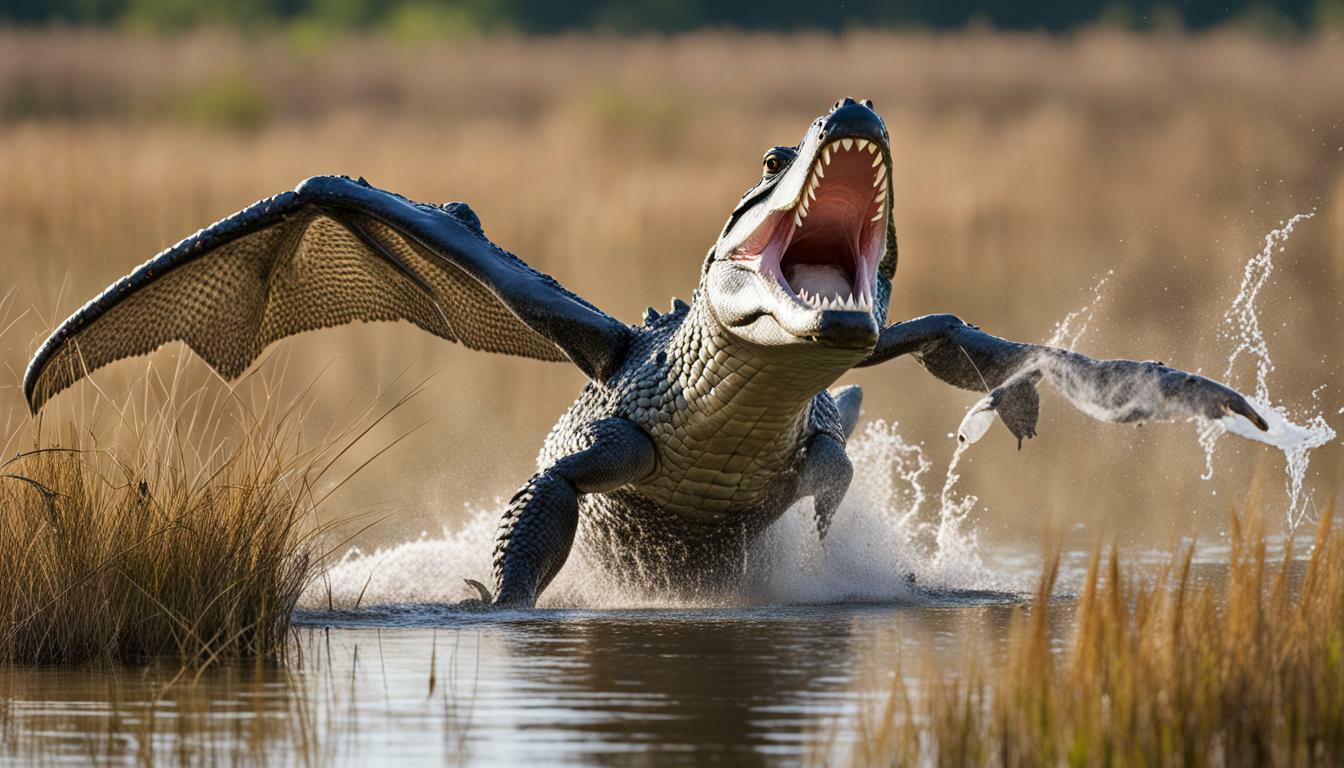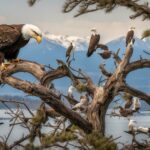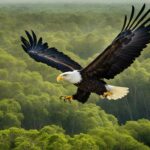When you think of alligators, you may imagine them preying on fish or other aquatic animals. However, did you know that alligators also have a habit of eating birds? In this section, we’ll explore the surprising diet of alligators and discuss their interactions with birds.
Key Takeaways:
- Alligators have been known to consume birds.
- It’s important to understand the role of birds in an alligator’s diet and their feeding patterns.
Alligator Feeding Behavior and Diet
Alligators are opportunistic predators that consume a variety of prey items, including birds. The role of birds in an alligator’s diet, however, is often underestimated. In fact, research has shown that birds can make up a significant portion of an alligator’s diet in certain ecosystems.
Bird consumption by alligators is most prevalent in wetland environments, where birds are abundant and easily accessible. Alligators are known to consume both aquatic and terrestrial birds, including waterfowl, wading birds, and even songbirds.
The consumption of birds by alligators is not only a result of their opportunistic nature but also their hunting techniques. Alligators often ambush their prey from the water, using their powerful jaws to grab and hold their victims. They also use their tails to stun prey, making them easier targets for consumption.
The consumption of birds is important for the overall health and survival of alligator populations. Birds provide essential nutrients and energy that help alligators grow and reproduce. In addition, the consumption of birds plays a crucial role in maintaining a balanced ecosystem, as alligators help regulate bird populations and prevent overpopulation.
Overall, the role of birds in an alligator’s diet should not be overlooked. While alligators consume a variety of prey items, their consumption of birds plays a crucial role in their overall health and the health of the ecosystem in which they live.
Hunting Techniques of Alligators
Alligators are known to be opportunistic predators, and birds are no exception to their vast prey selection. Yes, alligators do hunt and eat birds, especially during the breeding season when birds are actively nesting, making them easy targets.
Alligators have a unique hunting technique that allows them to ambush and capture birds in different ways. One of the most common methods involves lurking at the edge of a water body, waiting for birds to approach the banks to drink or feed. The alligator then launches itself out of the water with incredible speed and power, clamping its jaws on the unsuspecting bird.
Another method involves sneaking up on birds while swimming or wading in shallow water. Alligators will submerge their entire body, leaving only their eyes and nostrils above the waterline, making them difficult to detect. When a bird comes within striking distance, the alligator will suddenly lunge out of the water and grab the bird with its powerful jaws.
During breeding season, alligators may climb trees or shrubs to reach bird nests and consume the eggs, nestlings, or even adult birds.
It is essential to understand that birds serve as an important protein source in an alligator’s diet, especially during times when other prey is scarce.
Bird species frequently consumed by alligators
When it comes to the bird species that alligators most commonly consume, there are a few that stand out as favorites. These include:
- Great Blue Heron
- Cattle Egret
- Snowy Egret
- Roseate Spoonbill
These birds are often found in the same habitats as alligators, making them easy prey. Additionally, their size and behavior make them vulnerable to alligator attacks. For example, herons and egrets often stand still in shallow water to catch fish, making them easy targets for lurking alligators.
Alligators have been observed consuming other bird species as well, including smaller birds such as ducks and coots. However, their preference for larger bird species is well documented through bird sighting data and alligator feeding patterns.
It is important to note that alligators do not exclusively feed on birds, and their diet can vary depending on the availability of prey in their habitat. However, their consumption of birds does have an impact on the bird populations in these areas.
Impact of Birds on Alligator Ecosystem
It is well known that alligators are apex predators in their habitat, but what is less understood is the role that birds play in their ecosystem. Although many bird species fall prey to the alligator’s feeding habits, they also contribute to the alligator’s overall health and well-being.
One important aspect of their relationship is the fact that some bird species help to regulate the population of certain aquatic and terrestrial organisms. For example, wading birds such as herons and egrets consume large numbers of fish and crustaceans, which could otherwise overpopulate the alligator’s environment and disrupt the balance of the ecosystem. Thus, by consuming these birds, alligators help to regulate the populations of these organisms and ensure a healthier overall environment.
In addition, bird nesting sites are often located in alligator habitats. This provides an additional source of nutrients for the alligator population, especially during the breeding season when young alligators require a high-protein diet. By consuming bird eggs and nestlings, alligators are able to meet their dietary needs more easily, contributing to their overall health and well-being.
Overall, the interaction between alligators and birds is complex and multifaceted. While alligators may view some bird species as prey, they also benefit from the role that birds play in maintaining a balanced ecosystem. Thus, it is important to consider the broader implications of alligator-bird interactions when evaluating conservation efforts for both species.
Alligator’s Other Food Sources
While alligators have been observed consuming birds, they also rely on a wide range of other prey items to meet their nutritional needs. This includes fish, turtles, snakes, mammals, and even other alligators.
The composition of an alligator’s diet is largely influenced by factors such as habitat, size, and age. Young alligators feed primarily on insects and small fish, gradually transitioning to larger prey as they grow older.
As they reach maturity, alligators are capable of consuming larger prey items such as deer and wild boar. This adaptability in their diet is crucial for the survival of the species, as it allows them to thrive in a variety of habitats and ecosystems.
Despite the importance of other food sources, the habit of eating birds remains a significant component of an alligator’s diet. This is particularly true for individuals living in wetland habitats where birds are abundant.
Did you know? Alligators have a unique digestive system that enables them to extract nutrients from tough prey items such as bones and shells. Their stomach contains powerful acids that aid in the breakdown of food, allowing them to digest most of the prey they consume.
Alligator Conservation and Bird Protection
If you’re wondering about alligator habit of eating birds, it’s important to consider the broader ecological implications of this relationship. While birds may seem like easy targets for alligators, they actually play a crucial role in the ecosystem.
Alligators are apex predators and help to control the populations of other animals in their habitats. However, without the presence of birds, the ecosystem could become imbalanced. Birds help to disperse seeds and pollinate plants, which supports the growth of vegetation. This vegetation then provides food and shelter for other animals, thus ensuring a healthy food chain.
Despite the importance of alligators in their ecosystem, their interactions with birds can sometimes have negative consequences. Certain bird populations can be impacted by alligator predation, which can affect the balance of the ecosystem. As a result, conservation efforts are in place to protect both alligator populations and the bird species that are impacted by alligator predation.
Alligator conservation and bird protection programs aim to maintain a balance between predator and prey populations, while also preserving the integrity of the ecosystem. One such program is the Alligator Management Program, which regulates the hunting of alligators to ensure their populations remain stable. Additionally, bird protection programs work to ensure that bird populations are not negatively impacted by alligator predation.
In summary, while alligator habit of eating birds may seem like a simple interaction, it has important implications for the entire ecosystem. Conservation efforts are necessary to ensure the sustainable coexistence of alligators and birds, and to maintain a balanced and healthy ecosystem.
Conclusion
After exploring the unexpected diet of alligators and their habits of consuming birds, it is clear that these reptiles have a complex interaction with the ecosystem. Alligators have been found to consume a variety of birds, including herons, egrets, and ducks, and have adapted hunting techniques to catch their prey.
However, it is important to note that birds are just one part of an alligator’s diet. These apex predators also consume fish, mammals, and reptiles, among other prey items. Nevertheless, the impact that alligators have on bird species cannot be ignored, and conservation efforts aim to maintain a balance between the two.
By understanding the hunting and feeding habits of alligators, conservationists can work to protect vulnerable bird species while also preserving the essential ecological role that alligators play.
Protecting the Environment
It is crucial to maintain a balanced environment to ensure the sustainable coexistence of all species. Protecting the ecosystem in which alligators and birds live is vital, and it is essential to promote conservation efforts that help maintain this balance.
By balancing the needs of all species, we can ensure that both alligators and birds thrive in their natural habitat and maintain their role in the ecosystem.
Thank you for reading this guide on the unexpected diet of alligators and their habits of consuming birds. Remember to support conservation efforts to maintain the balance and sustainability of our environment.
Do Birds Included Worms in Their Diet?
Birds and their diets naturally include a variety of foods, and worms are a common part of their menu. Many bird species, like robins and thrushes, have a fondness for earthworms. These slimy creatures provide birds with essential nutrients, especially protein. So, it’s safe to say that birds indeed include worms in their diet, embracing the natural balance of their food choices.
FAQ
Q: Do alligators eat birds?
A: Yes, alligators do eat birds. They are opportunistic predators and will consume a variety of prey, including birds.
Q: What role do birds play in an alligator’s diet?
A: Birds serve as a part of an alligator’s diet, providing a source of nutrients and energy. However, the consumption of birds may vary depending on factors such as availability and prey preference.
Q: How do alligators hunt and catch birds?
A: Alligators use various hunting techniques to target birds as prey. They may lie in wait near water bodies, camouflaged among vegetation, and ambush birds as they approach. Alligators also employ stealth and speed to catch birds swimming or flying near the water’s surface.
Q: What bird species are frequently consumed by alligators?
A: Alligators have been observed consuming a range of bird species, including waterfowl, wading birds, and smaller shorebirds. The specific bird species consumed by alligators may vary depending on their habitat and feeding opportunities.
Q: How do birds impact the alligator ecosystem?
A: The interaction between alligators and birds contributes to the overall ecological balance of the alligator ecosystem. Birds may provide a food source for alligators, and their presence can influence the distribution and behavior of alligators within their habitat.
Q: What other food sources do alligators rely on apart from birds?
A: Alligators have a diverse diet that includes fish, turtles, mammals, and amphibians. They are opportunistic feeders and will consume any available prey that is suitable in size and proximity.
Q: What conservation efforts are in place to protect alligators and birds?
A: Conservation efforts are focused on maintaining healthy alligator populations while protecting bird species impacted by alligator predation. This includes habitat conservation, population monitoring, and the development of sustainable management strategies.











